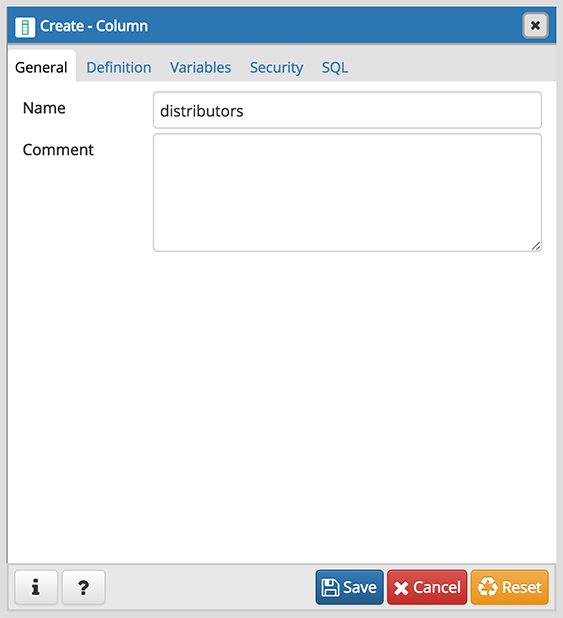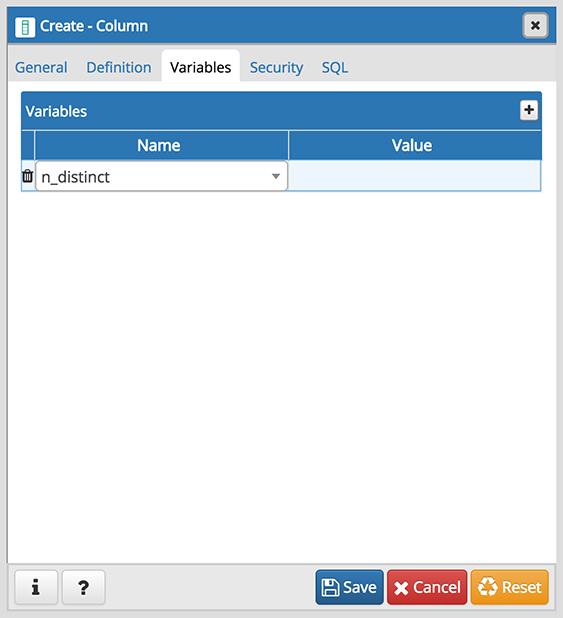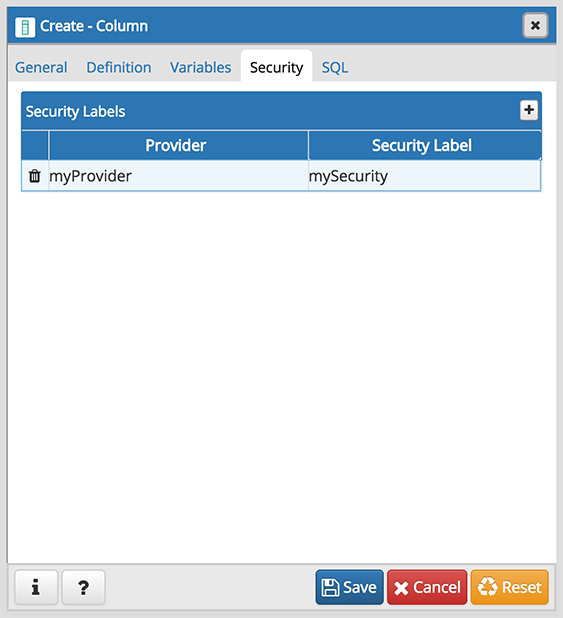Column Dialog - pgAdmin 4 3.2 documentation
Use the Column dialog to add a column to an existing table or modify a column definition.
The Column dialog organizes the development of a column through the following dialog tabs: General , Definition , and Security . The SQL tab displays the SQL code generated by dialog selections.

Use the fields in the General tab to identify the column:
- Use the Name field to add a descriptive name for the column. The name will be displayed in the pgAdmin tree control. This field is required.
- Store notes about the column in the Comment field.
Click the Definition tab to continue.

Use the fields in the Definition tab to add parameters for the column. (Fields are disabled if inapplicable.)
- Use the drop-down listbox next to Data Type to select a data type for the column. For more information on the data types that are supported by PostgreSQL, refer to Chapter 8 of the Postgres core documentation. This field is required.
- Use the Length and Precision fields to specify the maximum number of significant digits in a numeric value, or the maximum number of characters in a text value.
- Use the drop-down listbox next to Collation to apply a collation setting to the column.
- Use the Default Value field to specify a default data value.
- Move the Not Null switch to the Yes position to specify the column may not contain null values. The default is No .
Click the Variables tab to continue.

Use the Variables tab to to specify the number of distinct values that may be present in the column; this value overrides estimates made by the ANALYZE command. Click the Add icon (+) to add a Name / Value pair:
-
Select the name of the variable from the drop-down listbox in the Name field.
- Select n_distinct to specify the number of distinct values for the column.
- Select n_distinct_inherited to specify the number of distinct values for the table and its children.
-
Specify the number of distinct values in the Value field. For more information, see the documentation for ALTER TABLE .
Click the Add icon (+) to specify each additional Name / Value pair; to discard a variable, click the trash icon to the left of the row and confirm deletion in the Delete Row popup.
Click the Security tab to continue.

Use the Security tab to assign attributes and define security labels. Click the Add icon (+) to add each security label selection:
- Specify a security label provider in the Provider field. The named provider must be loaded and must consent to the proposed labeling operation.
- Specify a a security label in the Security Label field. The meaning of a given label is at the discretion of the label provider. PostgreSQL places no restrictions on whether or how a label provider must interpret security labels; it merely provides a mechanism for storing them.
Click the Add icon (+) to assign additional security labels; to discard a security label, click the trash icon to the left of the row and confirm deletion in the Delete Row popup.
Click the SQL tab to continue.
Your entries in the Column dialog generate a SQL command (see an example below). Use the SQL tab for review; revisit or switch tabs to make any changes to the SQL command.
Example
The following is an example of the sql command generated by user selections in the Column dialog:

The example shown demonstrates creating a column named territory in the table named distributors .
- Click the Info button (i) to access online help. View context-sensitive help in the Tabbed browser , where a new tab displays the PostgreSQL core documentation.
- Click the Save button to save work.
- Click the Cancel button to exit without saving work.
- Click the Reset button to restore configuration parameters.